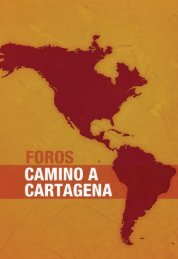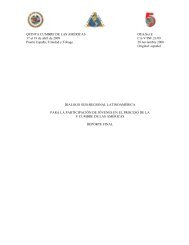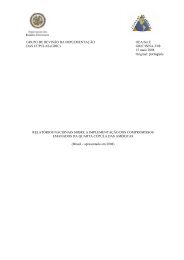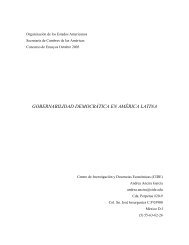The Road to Hemispheric Cooperation: Beyond the Cartagena
The Road to Hemispheric Cooperation: Beyond the Cartagena
The Road to Hemispheric Cooperation: Beyond the Cartagena
You also want an ePaper? Increase the reach of your titles
YUMPU automatically turns print PDFs into web optimized ePapers that Google loves.
<strong>The</strong> Context<br />
<strong>The</strong> Summit of <strong>the</strong> Americas is <strong>the</strong> only conference where<br />
all 34 democratically elected heads of state and government<br />
of <strong>the</strong> Western Hemisphere ga<strong>the</strong>r <strong>to</strong> discuss issues<br />
of common interest, affirm <strong>the</strong>ir shared values, and agree<br />
<strong>to</strong> take concerted action at national and regional levels.<br />
<strong>The</strong> Summit of <strong>the</strong> Americas is a process involving multiple<br />
ac<strong>to</strong>rs: governments, international organizations, financial<br />
institutions and civil society. As such, at least in<br />
<strong>the</strong>ory, it is <strong>the</strong> body that defines and articulates <strong>the</strong> vision<br />
and architecture of <strong>the</strong> inter-American system.<br />
<strong>The</strong> construction of <strong>the</strong> first institutions of <strong>the</strong> inter-American<br />
system began with <strong>the</strong> first American Conference held<br />
in Washing<strong>to</strong>n in 1889, when <strong>the</strong> Latin American countries<br />
and <strong>the</strong> United States decided <strong>to</strong> organize a set of legal<br />
rules and common institutions, based on shared principles:<br />
sovereign equality of states, <strong>the</strong> principle of non-intervention,<br />
non-use of force and peaceful settlement of disputes.<br />
This first conference was followed by o<strong>the</strong>rs, which approved<br />
a series of important treaties in public and private<br />
international law. At <strong>the</strong> same time, many inter-American<br />
institutions were created in <strong>the</strong> early years of last century <strong>to</strong><br />
concentrate on cooperation in areas of health, children, <strong>the</strong><br />
rights of women, legal issues, agriculture and commerce.<br />
During <strong>the</strong> period between 1889 and 1948, known as <strong>the</strong><br />
era of Pan-Americanism, many agreements were adopted<br />
<strong>to</strong> ensure peace among <strong>the</strong> American States, as well as<br />
resolutions and agreements <strong>to</strong> facilitate trade and legal<br />
cooperation. <strong>The</strong> first inter-American institutions were also<br />
created during <strong>the</strong> Cold War and in <strong>the</strong> context of <strong>the</strong> dominant<br />
U.S. anti-communist foreign policy in <strong>the</strong> region. In<br />
1947, <strong>the</strong> Treaty of Reciprocal Assistance (Rio Treaty) 1 established<br />
new procedures for regional collective defense. In<br />
1948, <strong>the</strong> Treaty on Pacific Settlement of Disputes marked<br />
a miles<strong>to</strong>ne in <strong>the</strong> efforts <strong>to</strong> ensure <strong>the</strong> peaceful settlement<br />
of disputes among American States at <strong>the</strong> regional level. 2<br />
All <strong>the</strong>se initiatives were incorporated in<strong>to</strong> <strong>the</strong> Organization<br />
of <strong>the</strong> American States (OAS), a regional organization<br />
created during <strong>the</strong> Ninth Conference of American States<br />
in Bogotá in 1948. During <strong>the</strong> years of <strong>the</strong> Cold War, <strong>the</strong><br />
OAS was often <strong>the</strong> scene of memorable disputes, as happened<br />
with <strong>the</strong> missile crisis in Cuba (1962), and <strong>the</strong> U.S.<br />
invasions of <strong>the</strong> Dominican Republic (1965) and Grenada<br />
(1983).<br />
Today, <strong>the</strong> OAS has 35 member states, from Canada <strong>to</strong> Argentina<br />
through <strong>the</strong> Caribbean and Central America, and<br />
68 permanent observer states, including China and Russia.<br />
It covers an area of 42 million square kilometers and<br />
a population of over 900 million. <strong>The</strong> OAS is <strong>the</strong> lead organization<br />
of <strong>the</strong> so-called inter-American system. <strong>The</strong> different<br />
organizations that form part of <strong>the</strong> system exercise<br />
specific functions in technical matters of common interest <strong>to</strong><br />
<strong>the</strong> American States: <strong>the</strong> Inter-American Children’s Institute<br />
(IIN), <strong>the</strong> Inter-American Commission of Women (CIM), <strong>the</strong><br />
Inter-American Indian Institute (III), <strong>the</strong> Inter-American Institute<br />
for <strong>Cooperation</strong> on Agriculture (IICA), <strong>the</strong> Pan American<br />
Health Organization (PAHO), <strong>the</strong> Pan American Institute of<br />
Geography and His<strong>to</strong>ry, and <strong>the</strong> Inter-American Court of<br />
Human Rights. <strong>The</strong> OAS also has two au<strong>to</strong>nomous organs,<br />
<strong>the</strong> Inter-American Juridical Committee (IAJC), 3 and <strong>the</strong><br />
Inter-American Commission of Human Rights (IACHR). 4<br />
At <strong>the</strong> core of this inter-American system, however, are<br />
<strong>the</strong> two regional institutions: <strong>the</strong> OAS and <strong>the</strong> Inter-American<br />
Development Bank (IDB), which were mandated by<br />
<strong>the</strong> Miami Summit in 1994 <strong>to</strong> support governments in <strong>the</strong><br />
implementation of <strong>the</strong> Miami Plan of Action. <strong>The</strong> IDB, <strong>the</strong><br />
oldest and largest regional multilateral development institution,<br />
was established in December 1959 <strong>to</strong> help accelerate<br />
economic and social development in Latin America<br />
and <strong>the</strong> Caribbean.<br />
While <strong>the</strong> inter-American summit process only started in<br />
1994, before this date two presidential summits had taken<br />
place under <strong>the</strong> auspices of <strong>the</strong> OAS. <strong>The</strong> first presidential<br />
summit was held in July 1956, when 19 American presidents<br />
met in Panama City, Panama. It was during this presidential<br />
summit that <strong>the</strong> IDB was created. <strong>The</strong> second summit,<br />
held in April 1967 in Punta del Este, Uruguay, convened 19<br />
hemispheric leaders, plus a representative from Haiti. <strong>The</strong>ir<br />
aim was <strong>to</strong> streng<strong>the</strong>n <strong>the</strong> Alliance for Progress, which was<br />
President Kennedy’s initiative <strong>to</strong> promote development and<br />
peaceful relations in <strong>the</strong> Americas. 5 <strong>The</strong> summit’s final declaration<br />
included <strong>the</strong> creation of a Latin American Common<br />
Market by 1980, albeit without <strong>the</strong> United States, and multilateral<br />
cooperation in infrastructure development, agriculture,<br />
arms control and education.<br />
<strong>The</strong> <strong>Road</strong> <strong>to</strong> <strong>Hemispheric</strong> <strong>Cooperation</strong>: <strong>Beyond</strong> <strong>the</strong> <strong>Cartagena</strong> Summit of <strong>the</strong> Americas<br />
<strong>The</strong> Brookings Institution ❘ Latin America Initiative<br />
91








